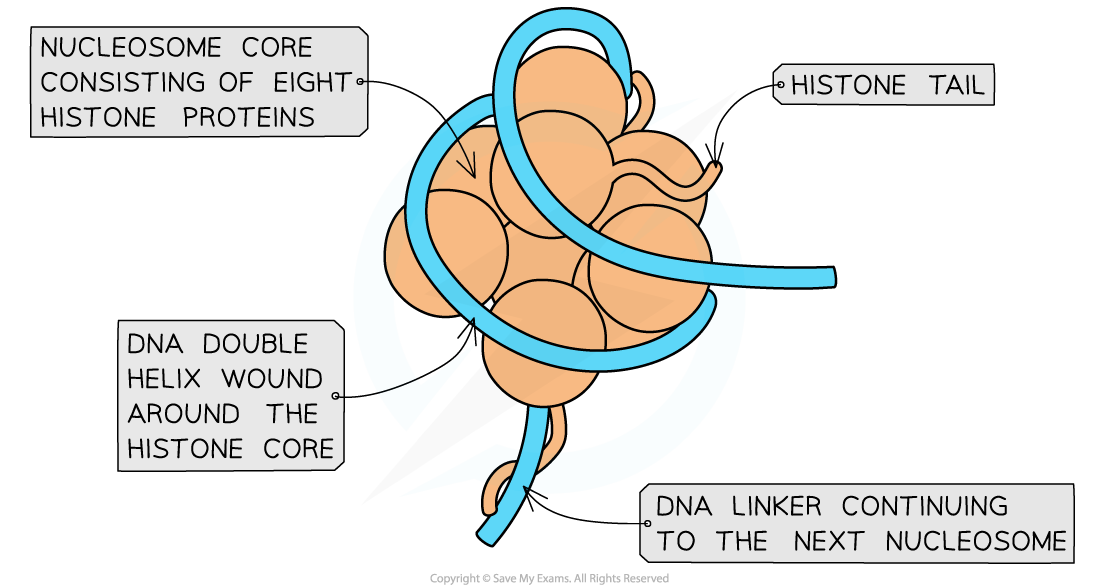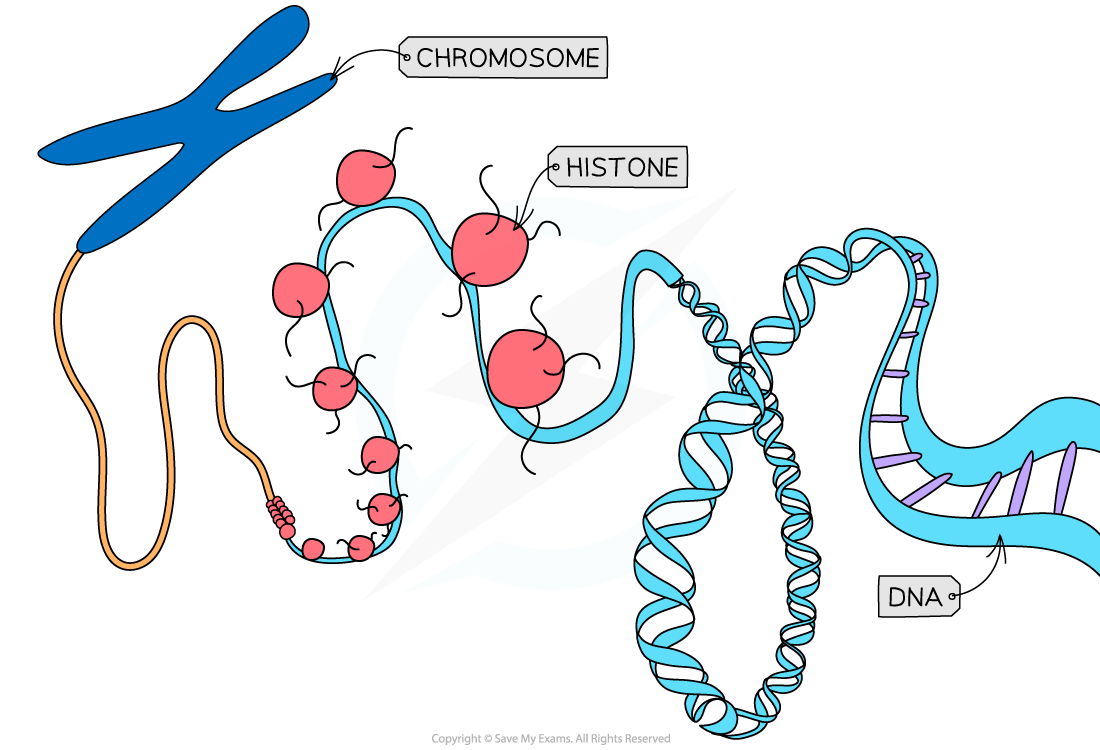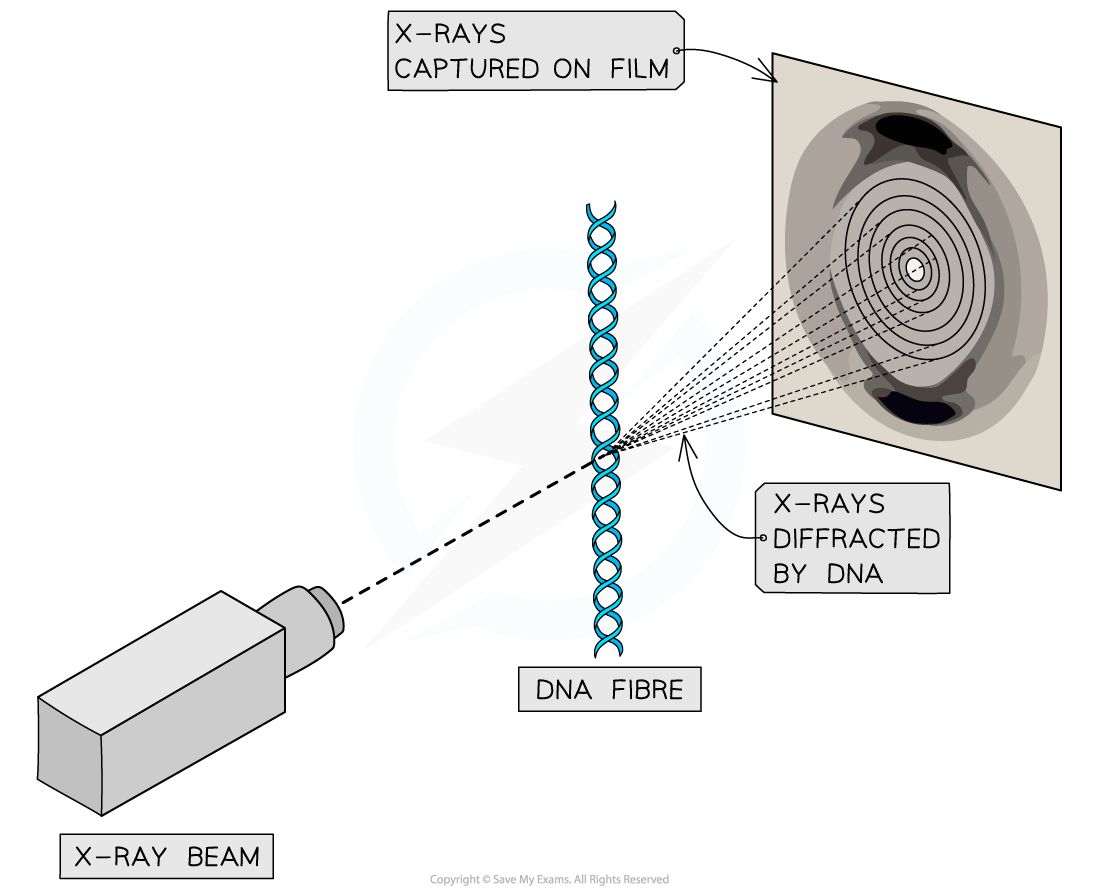- 翰林提供学术活动、国际课程、科研项目一站式留学背景提升服务!
- 400 888 0080
IB DP Biology: HL复习笔记7.1.1 DNA Structure
Nucleosomes
- Unlike most prokaryotic DNA which is referred to as ‘naked’, eukaryotic nuclear DNA is associated with proteins called histones (to form chromatin)
- Histones package the DNA into structures called nucleosomes
- The nucleosome consists of a strand of DNA coiled around a core of eight histone proteins (octamer) to form a bead-like structure
- DNA takes two turns around the histone core and is held in place by an additional histone protein
- The DNA molecule continues to be wound around a series of nucleosomes to form what looks like a ‘string of beads’
- Nucleosomes help to supercoil the DNA, resulting in a compact structure which saves space within the nucleus
- Nucleosomes also help to protect DNA and facilitate movement of chromosomes during cell division
- An analogy for supercoiling is twisting an elastic band repeatedly until it forms additional coils
- Nucleosomes can be tagged with proteins to promote or suppress transcription

Structure of a nucleosome

DNA is wrapped around a series of nucleosomes.
Nucleosomes coil tightly around each other to form the chromosome structure.
Nucleosomes coil tightly around each other to form the chromosome structure.
Franklin's Investigations
NOS Making careful observations—Rosalind Franklin’s X-ray diffraction provided crucial evidence that DNA is a double helix.
- In the 1950s, Rosalind Franklin and Maurice Wilkins used a technique called X-ray diffraction to study the structure of DNA
- Franklin’s work was instrumental to Crick and Watsons' model as the diffraction patterns indicated that DNA had a double-helical structure
- X-ray diffraction involves directing a beam of X-rays onto the molecule being studied
- X-rays have a shorter wavelength and higher energy than visible light
- The short wavelength allows X-rays to pass through the molecule, interacting with any electrons within the atoms
- The interaction causes X-rays to scatter (diffraction) at angles that indicate the arrangement of atoms
- The scattering pattern can be recorded on a film (similar to having an X-ray of a bone), with dark marks appearing where the X-rays strike the film
- Rotating the sample allows for the three-dimensional molecular structure to be studied
- Franklin was able to refine her methods and produce a clear diffraction pattern of DNA
- Using mathematical techniques and available knowledge about DNA, Franklin deduced that
- DNA strands were helices - as represented by the X-shape
- The pitch of the helix - as represented by the angle of the X-shape
- The distance between nucleotides
- Phosphates are located on the outside of the molecule
- DNA was double stranded

Summary of Rosalind Franklin’s X-ray diffraction investigation, the diffraction pattern represents the position of atoms in the sample of DNA
DNA Structure Suggests Semi-conservative Replication
- The discovery of the structure of DNA was due to experimental evidence and inputs from a range of independent researchers
- Franklin’s X-ray diffraction patterns identified a compact double helix
- Erwin Chargaff showed that DNA was composed of an equal number of purine and pyrimidine bases which suggested base pairing
- Crick and Watson used this evidence to build various physical models of DNA
- One model had the bases facing outwards but Franklin argued they should face inwards due to their hydrophobic nature
- It was determined that if adenine paired with thymine and cytosine paired with guanine in an antiparallel orientation a highly compact structure would result
- When Crick and Watson proposed their model for the structure of DNA, they realised that the double stranded structure suggested a mechanism for its replication during the cell cycle
- This was a key question that any model would have to address
- Crick and Watson stated that as one chain of the double helix was the complement of the other, either chain could act as a template during replication
- They postulated that hydrogen bonds break, allowing separation of the chains
- Each separate chain then acts as a template for the formation of a new complementary chain on itself
- This theory was called semi-conservative DNA replication as half of the original DNA molecule is kept (conserved) in each of the two new DNA molecules
- An opposing theory suggested DNA replicated ‘conservatively’
- The entire original DNA double helix would stay together and serve as a template for a new DNA molecule
- Crick and Watsons' theory of semi-conservative DNA replication was later proven by Meselson and Stahl

Semi-conservative replication of DNA
Exam Tip
You don't need to memorise the nature of purine and pyrimidine bases in DNA; C and T are pyrimidines; A and G are purines. A purine always bonds to a pyrimidine in the A-T and C-G rules of base-pairing.
转载自savemyexams

最新发布
© 2025. All Rights Reserved. 沪ICP备2023009024号-1









